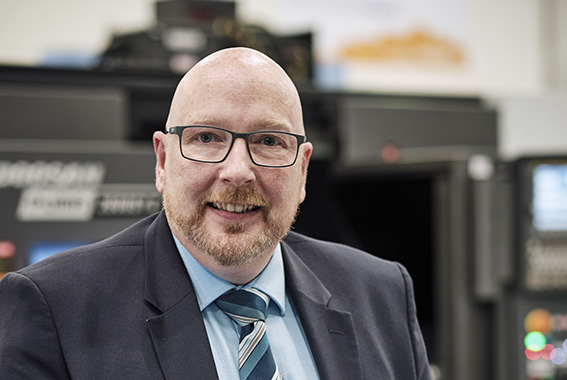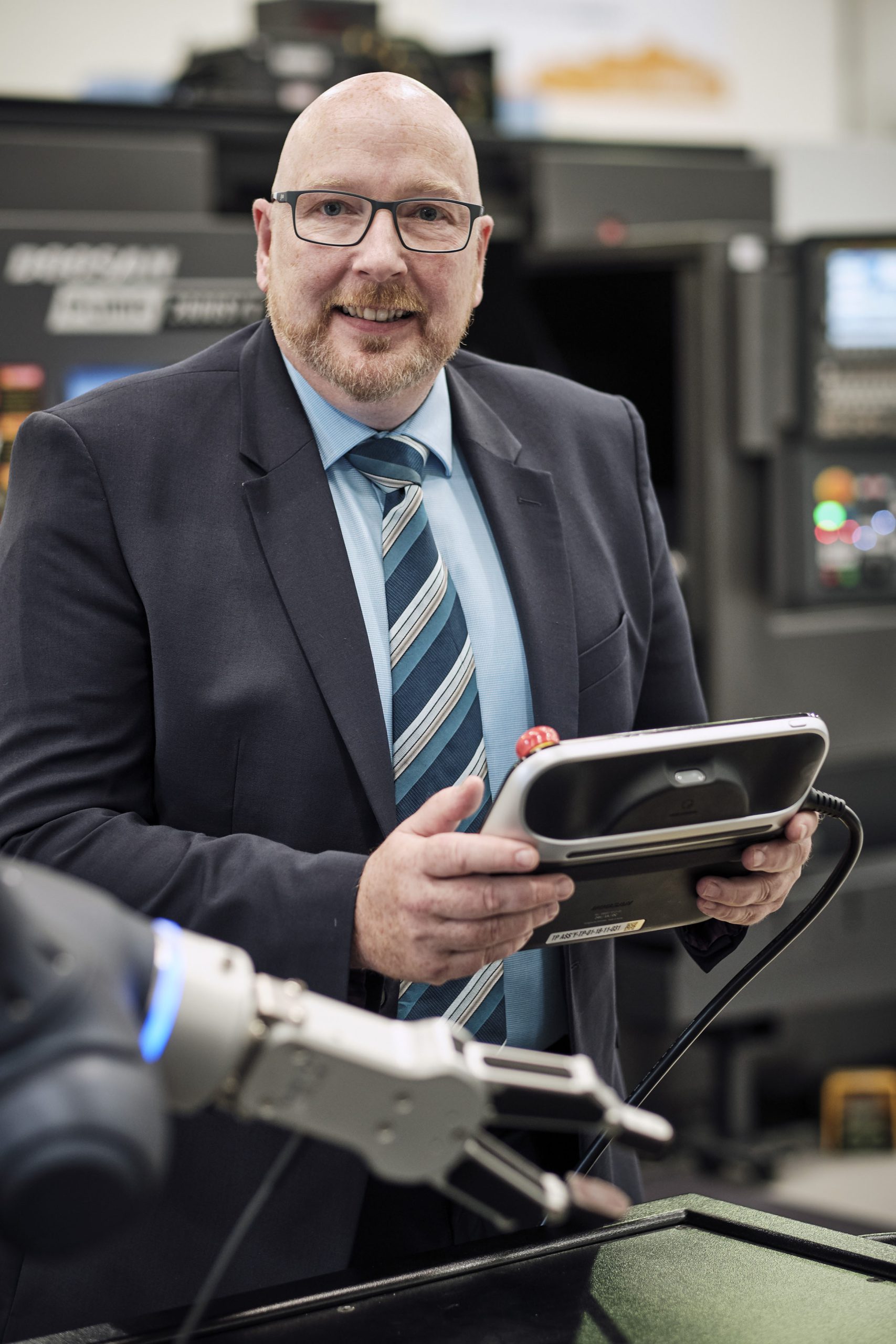
Robotics Business Review reports that the collaborative robotics market grew by more than 60% in 2018. With increased availability and adoption, revenues are forecasted to grow from $600 million to $7.6 billion over the next eight years.
So, what exactly is collaborative robotics and how does it differ from traditional robotics?

Peter McCullough, Product Manager (Doosan Cobots) at Mills CNC Automation brings us up-to-speed with the latest developments and applications in the healthcare and medical devices’ sectors.
“Despite anxiety-led headlines about robots coming for our jobs, collaborative robots are designed to work with and alongside operators and technicians, rather than replace them — making it possible to build work processes that incorporate the strengths of both humans and robots.
“Unlike traditional robots, cobots don’t pose a threat to human safety. Marked improvements in vision and sensor technology have made it possible to program cobots to stop working if a person is too close. Also, cobots are much lighter and smaller — some the size of a desk lamp. They’re significantly less expensive, easily programmable and quick to set up too.
Cobots are transforming the Healthcare Industry
“With the clear potential for streamlined processes, repeatable safety measures and a more efficient workforce, many in the healthcare and medical device sectors have also been quick to accept the future of collaborative robotics.
“Particularly encouraging is the development in the following areas.
Laboratory Testing
“Copenhagen University hospital is using cobots to pick up, sort and load blood samples for analysis. These cobots utilise vision programming by first picking up the sample, placing it in a bar code scanner, and then sorting the sample based on cap colour.
“Once a tray of the same colour is full, a second cobot places them in a machine for analysis. The pair of cobots handle 7 – 8 tubes of blood per minute or about 3,000 samples a day, ensuring that 90% of sample results are ready within one hour.
“This quick turnaround has resulted in positive patient outcomes. Out-patients can now receive results during their initial consultation rather than making an extra return trip to the hospital. Also, in-patients have same day results available by morning rounds, so physicians are reviewing accurate and up-to-date information.
Patient Care
Terapio, a cobot developed by researchers at Toyohashi University of Technology in Japan, is designed to give critical time back to busy nurses by providing bedside monitoring for patients and automatically updating electronic medical charts.
“With the ability to follow medical staff to each patient’s room and automatically upload vital signs to charts, nurses are relieved of administrative tasks and able to focus on patient care.
“Another cobot greeting patients at their bedside is RIBA (Robot for Interactive Body Assistance) that has a friendly bear-like face. Developed by RIKEN-SRK Collaboration Centre for Human-Interactive Robot Research and Sumitomo Riko Company, RIBA is working to serve the growing elderly population in Japan by lifting patients out of beds and wheelchairs — relieving care workers who can often sustain injuries from lifting patients up to 40 times a day.
Surgery
“One of the more familiar cobots in the surgery world is the da Vinci System, built with robot arms and high-tech cameras to assist surgeons during operations. The da Vinci’s arms translate surgeon hand movements into smaller, more precise movements, allowing for less invasive procedures.
Over 1 million patients worldwide had a da Vinci procedure in 2018 spanning many different types of surgeries.
“There are also other types of robots currently being used in surgery. Accuracy’s Cyberknife system delivers radiation therapy to cancerous tumours that utilise a pre-programmed treatment plan and can correct for movement in real time. Two multi-centre studies looking at Cyberknife treatment in prostate cancer patients showed a 97 – 100% success rate for low-risk patients and an 88 – 97% success rate for intermediate risk patients, both exceeding the success rates of conventional radiation therapy.
“Recently, we’ve also begun to see robotic applications in the complex field of brain and spinal surgery.
“Sebastian Koga, M.D., medical director of the Neuroscience Institute at Ochsner Health System is now assisted in surgery by Modus V, which was developed by Synaptive Medical Inc. The cobot provides a high-resolution view of the area being worked on by tracking surgical instruments in-use and then automatically moving its high-powered microscope to accommodate the surgeon.
“Stryker/Mako has also begun doing total knee arthroplasty (TKA) utilising a cobot system to reduce axis misalignment. Bone cuts are 5 times more precise with the system, which results in final component positions being 3.1 times more precise overall. The Mako Total Knee Robotic-Arm Assisted Surgery has also demonstrated soft tissue protection by improving the surgeon’s vision during cutting in regards to ligament disruption, reducing the need for tibial subluxation or patella eversion (which results in quicker recovery and improved function).
Medical Device Manufacturing
“India-based Aurolab, which manufactures cataract surgery kits and intra-ocular lenses use cobots to optimise their manufacturing processes.
“The cobots perform tasks such as material handling and careful picking and moving of the components — pivotal for the delicate process of manufacturing the lenses. After introducing eight cobots, Aurolab has seen a 15% increase in product output.
Applications Outside Healthcare
“With a smaller price tag and little expertise required for installation, even small and mid-size businesses are quickly finding ways to automate work processes with the help of cobots. And adaptation is happening across a multitude of industries.
Automotive
“As an industry with a lot of potentially dangerous tasks, automotive manufacturers are among the earlier early adopters of industrial robotics. They’ve also been some of the fastest to integrate cobots into their operations. For example, with improved vision technology, cobots are performing visual inspections to detect defects in machine parts — proving more accurate than the human eye.
Fulfilment centres
“Amazon fulfilment centres and several online grocery stores are using cobots to fill orders, saving workers the trouble of walking from shelf to shelf in the warehouses. Similarly, leveraging cobot technology, Chinese e-commerce company JD.com recently constructed a warehouse, which fills 200,000 orders a day with only four workers on site.
Food service
“Axium Food Inc., a mid-size food manufacturer, is using cobots to perform repetitive tasks that
in the past have caused human injury such as carpal tunnel. In the restaurant industry, where staff turnover is notoriously high, restaurants have begun adding cobots to the grill line to meet high demand — most famously, Flippy the burger-flipping cobot, began work at Caliburger (USA) in March 2018.
Industry predictions
“As cobots continue to meet the needs of the medical device and healthcare industries — providing high success rates and positive patient outcomes — we expect to see accelerated adoption rates.
